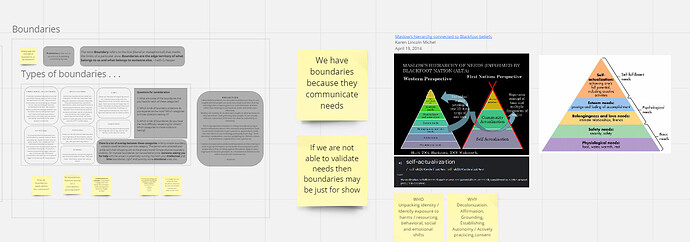Measuring TEC’s ecosystem health
How to measure the health of a DAO ecosystem was a central question of the Governauts research group on reward systems. The teams focused on TEC Praise put a high emphasis on Ostrom’s Principles as an indicator of health in the first phase of the program. Inspired by their progress, soft gov working group has been mapping out Ostrom’s implementations in the TEC as well as possible metrics to track their success.
This work evolved into the idea of a dashboard to track ecosystem health when @sidcode and @mmurthy from Karma joined the conversation. The first step they suggested was for us to understand the data we have and what can be measured. @bends, @Vyvy-vi, @vegayp, @gideonro and myself have started to organize this miro board and this spreadsheet which are still work in progress.
The idea is create metrics for each one of ostrom’s principles, these metrics are based on the implementations we have for each principle. From principle 1 to 8 we’ll have a collection of metrics that can be analyzed individually and also grouped by principle to give a broader perspective of how that principle is doing in the TEC. Let’s say we have 10 metrics to evaluate “clearly define boundaries” and we identify in each one what threshold indicates a desired level. If one or more of those 10 metrics are below a desired level, we can understand that “clearly defined boundaries” is suboptimal and how that might be affecting the health of the whole system.
Metrics can’t be set in stone, but mapping them all out and having clarity of what is an optimal outcome and a suboptimal one will also help us understand which metrics aren’t working and what are the changes that need to be done along the way.
The main challenge is to identify our measurement apparatus. So, what can be measured and how? Also, how is this going to be displayed? Could it be part of RAD dashboard, or should we use Karma, or another option? @zhiwei, @0xNuggan, @mattyjee, @octopus, @ygg_anderson, @kristoferlund @akrtws I would love to have your advice here.
The benefits of having a complex analytics like this plus RAD (reward analysis dashborad) in the TEC could be:
- Comprehensive feedback loop of our activities
- granularity to identify problems and propose solutions
- The system could become more independent and fluid (if core collaborators have to leave, there is a structure where others can understand what’s happening, plug in and address issues)
- We would be the first Commons, as far as I know, to have analytics based on Ostrom’s principles
- We could have scores to individuals based on these metrics, sum with the reward system score and create a wholesome reputation system.
- We would have more insight on the health of individuals and the organization.
This article from TalentDAO shared by @AL0YSI0US is exploring similar things and I’m excited to try the questionary they developed as complimentary data input.
This is the list of Ostrom’s 8 principles and some of their implementation in the TEC
the metrics we are exploring are in the miro board that was also shared above
1. Clearly defined boundaries
-
TEC token governance
-
Access rights for communication platforms
-
Roles
-
Community covenant and code of conduct
-
Discord onboarding journey
-
Polycentric governance
-
Trusted Seed for economy initialization
-
Reward system
-
Token vesting period
2. Congruence between provision and appropriation
-
Entry and exit tribute
-
Value provided by TE proposals
-
TEC products
-
Working group services
-
Conviction Voting
-
Reward system analysis
-
Initial buy and LASERTAG
-
MVV and community covenant
-
TEC token liquidity
3. Collective Choice Arrangements
-
Do-ocracy
-
Individual and wg agency
-
Onboarding and education
-
Collaborative economics/ params dashboard
-
Polycentric governance framework
-
MVV
-
Sprint planning
-
Sprint retrospective
-
Praise quant
-
Sourcecred params
-
Inclusive culture
-
Templates
4. Monitoring
-
Sprint planning
-
Sprint retrospective
-
Advice process
-
Recording of meetings available on youtube
-
Proposals on forum
-
Public calendar
-
Github issues
-
Community and working group calls
-
Praise and praise quants
-
Reward system analysis
-
Transparency audits
5. Graduated sanctions (more work needed)
-
Celeste collateral tokens
-
Graduated bannings
-
1 on 1 reach out
-
Warning plus admin power to delete harmful content
6. Conflict resolution mechanisms
-
Accessibility to get in touch with Gravitons at no cost
-
Gravity typeform
-
Graviton trainings
-
Graviton roles displayed on discord
-
TE lounge
-
NVC education
-
Psychology initiative
-
Community rituals
-
Celeste
7. Minimal recognition of rights to organize
-
Trusted Seed legal entity
-
Covenant
-
Legal working group
8. Nested enterprises
-
Sourcecred integration
-
Snapshot integration
-
Param parties in other communities
-
Tech build from 1hive
-
TE Academy partnership
-
Working groups becoming squad DAOs
-
Proposal inverter in partnership with PrimeDAO
-
Blockchain for good community
-
Commons Stack partnership
-
Block Science relationship
-
General Magic partnership
-
Longtail financial relationship

